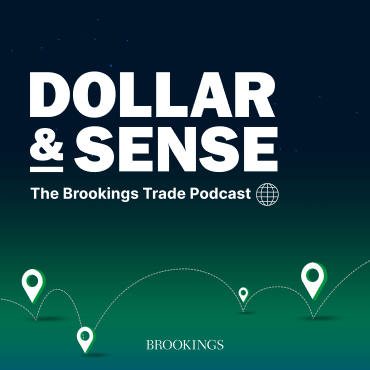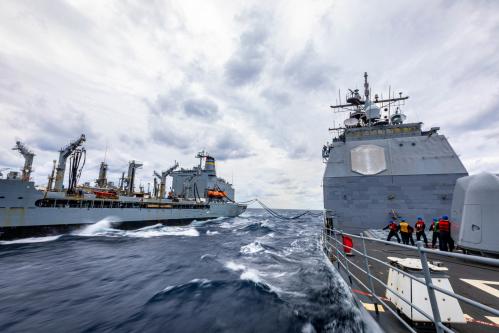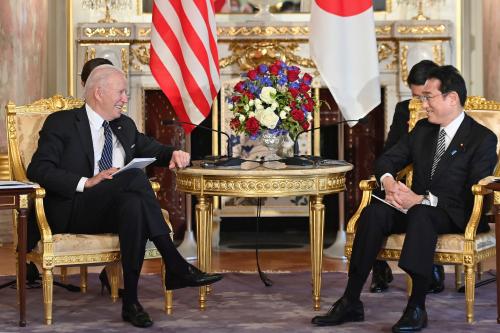Mireya Solís, director of the Center for East Asian Policy Studies at Brookings, explains the significance of Japan hosting the G7 summit in Hiroshima, and how Tokyo centers its foreign policy on promoting a free and open Indo-Pacific region. “This is Japan’s grand strategy,” Solís says, “this is really the roadmap that Japan has charted to achieve its security and prosperity.”
- Listen to Dollar & Sense on Apple, Spotify, Google, or wherever you like to get podcasts.
- Learn about other Brookings podcasts from the Brookings Podcast Network.
- Sign up for the podcasts newsletter for occasional updates on featured episodes and new shows.
- Send feedback email to [email protected].
TRANSCRIPT
[music]
DOLLAR: Hi, I’m David Dollar, host of the Brookings Trade podcast Dollar and Sense. Today, my guest is Mireya Solís, director of the Center for East Asian Policy Studies here at Brookings. Mireya is a leading expert on Japan’s trade and economic diplomacy, and she has a book coming out this summer on Japan’s quiet leadership. And one aspect of this quiet leadership, or maybe not so quiet right now, is Japan will be hosting the G7 summit in Hiroshima starting on May 19. That’s the main thing we’re going to talk about.
Because of the Memorial Day holiday in the United States, we’re going to push back production one week. So, the next episode will come out on June 5th.
So, welcome to the show, Mireya.
SOLÍS: Thank you so much, David. It’s a pleasure to be here.
DOLLAR: So, let’s start with this choice of Hiroshima as the city. Is there important symbolism in convening the G7 leaders together in Hiroshima, Japan?
SOLÍS: Yes, indeed. I mean, if you think that there are only two places in the world that have suffered the devastation of an atomic attack, that is Hiroshima and Nagasaki. So, I think that by convening the G7 in Hiroshima, Japan is trying to send a very powerful message about the dire consequences of unrestrained geopolitical conflict.
And of course, it’s a message that resonates today. If you think about what’s happening in world politics, the fact that Putin, for example, has hinted at the possibility of using tactical nuclear weapons as it embarks on its invasion of Ukraine; if you think about how actively North Korea is testing nuclear capable missiles in the region, and some of them have actually overflown Japanese territory; and when you consider also, David, that we’re increasingly worried about the United States-China relationship veering into conflict, perhaps possibly over a Taiwan contingency—these are superpowers on the nuclear issue—and therefore, I think that Hiroshima encapsulates a very poignant reminder of the need to address these issues and avoid a similar outcome.
DOLLAR: Japan’s foreign policy has been centered on promoting a free and open Indo-Pacific. This is a language that’s been picked up by others, but I think it really originated from Japan. So, what exactly does Japan mean by a free and open Indo-Pacific?
SOLÍS: I think, this is Japan’s grand strategy. This is really the roadmap that Japan has charted to achieve its security and prosperity. And it really embarks upon a whole of government decision-making and also using all levers of statecraft. So, it’s based on a number of fundamental principles on how to achieve regional stability. How can you structure relations among states so that you can preserve the peace and grow the economy, which I think are ultimately the key goals here.
So, what are the principles? Well, first of all, respect for the rule of law, freedom from coercion, eliminating the use of force to change borders and, of course, freedom of navigation. So, if you have those principles in place I think that the notion is that then you can have regional stability and then it’s about then creating economic opportunity.
And there is a very strong element here, David, of connectivity. I think this is really Japan’s calling card. So, what Japan has been doing in the past few years is that it has stepped up its game and Japan now is founder or leading participant in very large-scale trade agreements. Japan has a very robust program of infrastructure finance. Japan is very interested in disseminating standards for the digital economy. And of course Japanese companies are very important players in the global supply chain. So, this is about how you create these connections where the region feels more integrated and you can tap on that dynamism.
But there’s also another way in which connectivity is understood in this free and open Indo-Pacific, and that has to do with security cooperation. So, Japan certainly, very interested in deepening the alliance with the United States, but it has also expanded its horizons, if you will, looking for other partners on security cooperation. And people talk about perhaps a quasi-alliance with Australia, that relationship is very strong; with India, certainly, there’s a lot happening in Japan-India relations; and also an upgrade in security cooperation with the UK, with Vietnam, with other regional partners. So, really when I think about Japan’s grand strategy, the word that comes mostly to mind is “connectivity,” understood both in its economic and security elements.
DOLLAR: So, that was very helpful, Mireya. So, I take that joint objective, the security on the one hand, but also economic connectivity on the other. And you mentioned that Japan is participating in relatively new large trade agreements. That includes the Regional Comprehensive Economic Partnership. And they really were the leaders in keeping alive the Trans-Pacific Partnership, renaming it the Comprehensive and Progressive Trans-Pacific Partnership. Now, the U.S. is not active in these new trade agreements. So, my next question is, is there tension between the U.S. and Japan on this economic side of the equation with Japan basically connecting to other countries through new agreements, the U.S. staying out of these agreements and shifting somewhat in a protectionist direction?
SOLÍS: Yes, I mean, I think there is significant frustration. I wouldn’t call it friction or tension necessarily, but certainly this is one very important area where Japan and the United States are not working hand-in-hand. And you described how Japan is now really very important to these mega trade agreements. And on the other hand, what we hear from the United States is that they do not believe any longer on the benefits of traditional free trade agreements, tariff liberalization, market access negotiations—they have become almost a taboo here in U.S. domestic politics.
And instead, what the United States is putting on the table is something that is called the Indo-Pacific Economic Framework, that is trying to codify standards, say, on environment, on labor, on the supply chain resilience in the digital economy. But it’s possible we don’t have the outcome yet, but it’s possible that there would be large part soft commitments about a desire to move in a certain direction. But it’s hard to see actionable, binding commitments. We’ll have to see. But the one thing that is Indo-Pacific economic framework will not entertain, David, is market access, trade liberalization.
Now, I say frustration because it has become almost like a ritual in every important U.S.-Japan meeting you have this exchange where Japan would encourage the United States to return to the Trans-Pacific Partnership, that project, and now it’s new label, the Comprehensive and Progressive TPP. And I can almost see the face of the American counterparts in that meeting. It’s frustration. Why are Japanese counterparts reminding us of that when we’ve already said loud and clear that that’s not where we’re heading? But the way I think of it is that good friends always tell you the honest truth. And I think that Japan is making an important point to the United States: that the United States will not be able to fully consolidate its presence in the emerging regional architecture if it does not speak the language of the region.
And this is a region, a strong believer still in these free trade agreements that are very comprehensive, but where market access or that tariff liberalization is an important anchor, is what provides a lot of the benefits that then persuade countries to embark on the negotiation of rules on investment, labor, you name it.
And I also think that from the point of view of Japan, the United States cannot really compete with China, even though the United States is constantly remarking on how important it is to compete with China, that you cannot do that if you basically are operating tying one arm behind your back, and therefore that the United States should utilize all instruments of foreign economic policy.
So, that’s certainly an element where the two sides are not working the same direction. And where I think this is creating is frustration that there is this untapped potential for that partnership where they are operating on the same page here.
DOLLAR: Mireya, you brought up the issue of China, so let’s go into that a little bit more. It seems to me Japan has a vision of the Asian economy that includes engaging with China. I think Japanese leaders like this language of de-risking our economic relationship with China, but not decoupling. Japan is pretty deeply integrated, South Korea I think even more so deeply integrated, Australia. So, most of our Asia-Pacific partners want to continue to engage China despite having various concerns.
Actually the United States, to be fair, we’ve heard from some cabinet officials, Janet Yellen, a couple of weeks ago, Jake Sullivan here at Brookings—they’ve been using this language of de-risking, at least Jake Sullivan did, in talking about we’re not trying to keep China down, the U.S. is not trying to keep China down. But the U.S. does keep rolling out more and more restrictions on trade and investment with China, and I expect that to continue. And the politics in the U.S. certainly continues to push in that direction. So, is that an additional source of friction between the U.S. and Japan? Is there some daylight in terms of how we see the economic engagement with China?
SOLÍS: I think that this is an issue that’s central to both countries, to both governments. Overall, I would say there is very strong alignment. I think that both the United States and Japan are concerned about the direction that China is taking. They’re concerned about China’s military buildup. They’re concerned about China’s coercive tactics to advance its territorial claims in the region. And they’re also worried about how China is doubling down on its state capitalism practices to build this dominance on technology. So, in diagnosing the problem, I actually see a lot of alignment. I also think that the shared goals in terms of reducing overdependence on China, building resilience to our supply chains and on developing and nurturing the next crop of advanced technologies.
So, it’s very good news, if you will, that the United States and Japan are very aligned on these very important issues. But their China policies are certainly not identical. And there are areas where there are some differences, and therefore a lot of what these countries now have to do is that they have to talk about those differences and how they can coordinate more effectively.
And let me highlight some of those differences. First of all, I would posit that Japan takes a more pragmatic position when it comes to China’s place in the regional economy, and that Japan is willing to negotiate a trade agreement with China. You mentioned the Regional Comprehensive Economic Partnership, because Japan recognizes the reality of its existing integration and the role that China plays in the region. Whereas we know that the Indo-Pacific Economic Framework does not anticipate China’s membership anytime in the near future.
So, I think that that already sends a very important signal to the other countries in the region that Japan is not in any way advancing a zero-sum competition with China. And we know that the U.S. is making that point rhetorically, but whether it’s making it in terms of its actions remains, I think, something that we need to wait and see how this plays out.
Then another difference related to this, I think that Japan is certainly trying to hedge against its existing vulnerabilities with economic interaction with China. But when Japan engages in this kind of hedging, diversification plays a larger role than it does in the United States. The United States is doing a lot of onshoring, right, with domestic content provisions in the Inflation Reduction Act, for instance, trying to bring this advanced manufacturing to the United States and putting conditions that if you receive those subsidies, say, through the CHIPS and Science Act, you cannot expand substantively in China for the next ten years.
Japan is doing things very differently. Japan is offering incentives for companies that have been producing in China to perhaps bring some of that production back to Japan, but also they can bring that production to elsewhere in Southeast Asia. And there’s nothing that would restrict the ability of firms to receive subsidies and expand in China.
So, I think that those are important differences on the ground of how they pursue their derisking when it comes to China.
And the last point, I think, where there’s a difference—and we might see some of these actually come up in the G7—I think that Japan, and probably this applies as well to European Union, they are still thinking when they are fleshing out what we refer to as economic security policies, these derisking policies—and China is, of course, the main concern—they’re also very aware of what are the implications for WTO disciplines, and they want to make sure that they do not necessarily want the anti-discrimination principle, nondiscrimination principle of the WTO.
So, a lot of the policies that we see coming recently from the United States, they have a target, an explicit target, that is China. And Japan does not want to go there. So, Japan, for example, rolled out new regulations on export controls just recently in March in the aftermath of a negotiation with the United States because of the October 7th export control decision. But Japan’s regulations do not single out China. They’re just more general regulations about some production equipment that will be subject to export control, regardless of where this is sent to. So, this is, I think, important because it puts a limit to how far U.S. partners are willing to go on China-specific restrictions.
DOLLAR: That’s interesting, Mireya, how you explain some of the differences in the U.S. and the Japan approach. Listening to that, it strikes me that in the data we do not really see much reshoring back to the United States, not in any kind of macro sense. If you look at manufacturing as a share of the economy or what’s happening with manufacturing trade, we don’t see any large shifts in favor of onshoring to the U.S.
On the other hand, we do see some evidence of the evolution of value chains, a certain amount of multinational production is shifting to Southeast Asia, and that’s noticeable in the data. China exports growing a little bit less rapidly in places like Vietnam, exports growing extremely rapidly. Also Malaysia, some of the other Southeast Asian countries. So, the Japanese approach you describe is probably more realistic than expecting a lot of this production to move back to the United States.
SOLÍS: Yes. And you know, it’s interesting, David, because if you look at some opinion polls of Japanese multinationals, how they think about the China market, I think that more and more they’re making a distinction. So, if you ask them, how do you think about China as a hub for the global supply chain where most of that production will then be exported elsewhere? Well, they think that China’s prospect is not as bright as they were before. But when you ask them about the significance of China for its domestic market, they obviously remain very interested. And therefore, we begin to see this distinction between serving the Chinese market there probably will stay put. But when we think about the broader regional production network, maybe a lot of that production can be taken elsewhere.
DOLLAR: Since we’re talking about some of the shift to some of the other developing countries, particularly in Asia, my next question is about the participation in this G7 summit, which of course involves the G7 leaders by definition. But I found it interesting that Japan has invited a pretty large number of heads of other of developing countries, including India, Brazil, Indonesia, Vietnam, I think the head of the African Union. So, what is Japan trying to do by diversifying out the participation in this summit?
SOLÍS: It really has emerged as a very important priority in Japanese foreign policy to engage with the Global South, with the developing world. I think that Japan, like many others, was shocked to see that when Russia invaded Ukraine, many developing countries were not willing to speak out or were not willing to condemn forcefully Russia’s action. And therefore Japan felt the need to double down on its engagement. And I think that’s why it’s inviting these countries to come to Hiroshima. The idea is that the G7 traditionally has been a club of industrialized Western nations. And therefore, what Japan is trying to do also as the only Asian country in the grouping, is to make sure that the G7 builds bridges with a larger set of countries. So, to bring that diversity of views.
Now, in preparation for this, it’s interesting, David, that just last March, Japan relaunched its free and open Indo-Pacific during a visit of Prime Minister Kishida to India. And they made additional commitments, $75 billion, but they’re also making the case that the new free and open Indo-Pacific is going to have wider geographical scope and also now include the Middle East and Latin America. So, clearly there’s the effort there.
Now, there are many challenges. First of all, I think that it would be important to ditch the Global South label because it’s, again, a very broad term that does not really capture the complexities, the diversity, the specificity of different regions, different countries. And the question, of course, is that Japan is trying to do more engagement, and it’s indeed putting resources on the table. If you’re trying to cover a wider distance, those resources might not be enough. So, a question of capacity is, I think, on the table.
But yeah, I mean, that certainly is a message that Japan wants to send in hosting the G7, that it’s very important to embark on, perhaps could be described as inclusive diplomacy, and that the G7’s promise, even though the G7 really has come alive because it has stepped up in the aftermath of Russia’s invasion, that ultimately success will be measured by the extent to which you also bring diverse countries to the place you want them to be in terms of thinking about the sources of stability in the international system.
DOLLAR: So, last question for you, Mireya. South Korea is also invited, the leader of South Korea is also invited. And clearly Japan and South Korea continue to have somewhat tense relations. And this is an issue for the United States because these are two really close allies and economic partners. And from the U.S. point of view, we would prefer that they get along. So, is there much hope that that relationship can improve? Can a summit or a meeting on the side between the leaders of Japan and South Korea, can that maybe generate one of the important outputs of this summit?
SOLÍS: I see promise of that. I think that this G7 summit is coming on the heels of a very important movement of rapprochement between Japan and South Korea. It’s very recent. Just in the past few months, President Yoon really gave momentum to this when he decided on a formula to solve the forced labor issue, wartime forced labor issue. And that would require that Korean companies are going to make contributions to a compensation fund and the contributions from Japanese companies will be voluntary.
That created the space for Japan and South Korea to begin to come closer and begin to flesh out the many areas where they can collaborate. Very quickly, they solved an export control dispute they had in advanced chemicals for semiconductors. They have now restarted shuttle diplomacy with both leaders traveling frequently to visit one another—Kishida was just in Seoul a few days ago, and then President Yoon will go to Hiroshima.
I think a very interesting piece of news that has come is that Japan is going to invite an expert group from South Korea to discuss the planned release of treated water from the Fukushima nuclear plant, which obviously is of great concern to South Korea. So, that confidence building measure.
They have worked now to develop closer collaboration on economic security, on sharing information about North Korea’s nuclear missile program. So, a lot of potential benefits of making this relationship functional.
Now, we started our conversation, David, talking about the symbolism of Hiroshima, and I think that it applies here as well. Because it is reported that President Yoon and Prime Minister Kishida will visit a memorial for the Korean victims of the atomic bomb. And I think that this offers a new way to address the pain of the past and hopefully heal in that manner.
I also think it sends, again, a very important message about how operating in this increasingly dangerous neighborhood, the ability for South Korea and Japan to work together to improve their security is important.
And the last symbolism, I think, of this Hiroshima venue, I think, is that when you think about it, it also speaks about the enormous potential of reconciliation. Because in my mind, one of the most remarkable stories of reconciliation is between Japan and the United States. They were the bitterest of enemies in World War II. Hiroshima and Nagasaki are the evidence of that. And therefore, I think that that’s another meaning, I think, to that visit of President Yoon on the occasion of the G7.
DOLLAR: I’m David Dollar and I’ve been talking to my colleague Mireya Solis, about Japan’s quiet leadership. That’s the title of her book coming out this summer. But we wanted to preview some of the issues because of Japan’s leadership hosting the G7 summit in Japan starting on May 19th. So thank you, Mireya.
SOLÍS: My pleasure. Thank you.
DOLLAR: Thank you all for listening. We release new episodes of Dollar and Sense every other week. So, if you haven’t already, follow us wherever you get podcasts and stay tuned.
[music]
It’s made possible by support from supervising producer Kuwilileni Hauwanga; producer Fred Dews; audio engineer Gastón Reboredo; and other Brookings colleagues. Show art is by Katie Merris.
If you have questions about the show or episode suggestions, you can email us at Podcasts at Brookings dot edu. Dollar and Sense is part of the Brookings Podcast Network. Find more podcasts on our website, Brookings dot edu slash Podcasts.
Until next time, I’m David Dollar and this has been Dollar and Sense.
The Brookings Institution is committed to quality, independence, and impact.
We are supported by a diverse array of funders. In line with our values and policies, each Brookings publication represents the sole views of its author(s).








Commentary
PodcastJapan’s quiet leadership as it hosts the G7 summit in Hiroshima
May 15, 2023
Listen on
Dollar and Sense Podcast